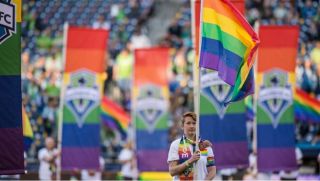Transgender
LGBTQ+ Representation in Sports Is at an All-Time High
Strategies to support LGBTQ+ athletes in sports spaces.
Posted July 4, 2024 Reviewed by Michelle Quirk
Key points
- LGBTQ+ representation in sports is at an all-time high.
- LGBTQ+ athletes face unique stressors within and outside of sports participation.
- Sports organizations should be prepared to create LGBTQ+ inclusive environments.
Nearly 200 out lesbian, gay, bisexual, transgender, and queer-inclusive (LGBTQ+) athletes competed in the 2020 Tokyo Olympic Games, including the first transgender and nonbinary competitors. At least 22 LGBTQ+ athletes also competed in the 2020 Tokyo Paralympic Games. These numbers are likely to be surpassed in the 2024 Paris Olympic Games, where LGBTQ+ fans and athletes can again come together at Pride House on the Seine River to watch LGBTQ+ athletes compete during the games.

Prominent athletes, including former USWNT star Megan Rapinoe, former NFL defensive end Carl Nassib, and Team USA triathlete Chris Mosier, have publicly advocated for LGBTQ+ inclusion in sports. Organizations like Athlete Ally have dedicated their mission to the same, while prominent companies like Adidas and Lebron James’ Uninterrupted have collaborated on LGBTQ+ inclusive campaigns. Finally, the International Olympic Committee released a framework of guidelines to encourage the inclusion and safety of LGBTQ+ athletes in 2021, and the NCAA updated its Transgender Student-Athlete Participation Policy as recently as May 2024.
According to the National Collegiate Athletics Association (NCAA), estimates of LGBTQ+ identity in collegiate sports are 14.2 percent LGBT and 1.6 percent transgender/nonbinary, though widespread underreporting is likely, and these rates differ by NCAA division, sport type, and political climate of institutions (Mullin, Baeth, & Vieira, 2023). The Trevor Project reports that nearly one in three LGBTQ+ youth participate in sports. With LGBTQ+ representation in sports at an all-time high, understanding how to best support LGBTQ+ athletes in sports spaces is imperative.
While some athletes tend to have positive responses when coming out as LGBTQ+ to teammates, the fear of doing so (and not having clear evidence of support), can prevent some from sharing at all. In addition, LGBTQ+ individuals face unique stressors both within and outside of sports participation, including elevated mental health concerns, fears and negative experiences with coming out, and navigating anti-LGBTQ legislation. Further, LGBTQ+ athletes are 28 times more likely to report harassment based on identity, four times more likely to be pressured to stay silent about their identity, and six times more likely to be singled out as a “resident authority” on their sexual identity (Rankin & Merson, 2012). Nonbinary and transgender athletes further experience exclusion from sports and invasive medical screenings and testing.

Ultimately, the overall climate of a sports environment directly affects athletic and other life outcomes for LGBTQ+ athletes. Sports organizations can foster climates of inclusion by reviewing policies related to nondiscrimination, trans inclusion, sexual harassment, and both team and fan codes of conduct. Using LGBTQ+ inclusive language and avoiding derogatory and gender-based terms in policy documents and media communications is recommended.
Those working within sports organizations should respect LGBTQ+ athletes' privacy, names, and pronouns. Ensuring access to LGBTQ+ inclusive locker rooms, uniform options, and travel and lodging assignments are also recommended. Further, visible signs of LGBT+ inclusion throughout sports spaces can include pride flags/signs and hosting pride matches and games. Providing LGBTQ+ trainings for staff and athletes, such as bringing in speakers or trainings (see Athlete Ally’s Champions of Inclusion training), are also recommended. Finally, ensuring LGBTQ+ athletes have access to comprehensive, gender-affirming counseling and health care is imperative.
References
Mullin, E. M., Baeth, A., & Vieira, K. (2023). Sexual orientation and gender identities among NCAA athletes: A pilot study. Journal of Issues in Intercollegiate Athletics, 16(1), 19.
Rankin, S., & Merson, D. (2012). Campus Pride 2012 LGBTQ national college athlete report. Campus Pride.
Olivia B. Waxman. The History Behind Pride House at the Olympics. Time. June 27, 2024.
Scott Bregman. Megan Rapinoe's visibility shines a light for the LGBTQ+ community. International Olympic Committee. June 1, 2023.
Kevin Patra. Carl Nassib, first active NFL player to come out as gay, announces retirement from football. NFL. September 6, 2023.
Chris Mosier. About.
Adidas. THE POWER OF LOVE UNITES. June 2021.
Lebron James’ Uninterrupted. Q and Athlete.


